4 Simple and Natural Ways to Kill Mold
Before you’re tempted to pull out the bleach, consider these 4 natural ways to kill mold which are safer for your home and family. These cheap and effective methods help to kill mold naturally without toxic ingredients.

What Causes Mold?
This post contains affiliate links. Please read my affiliate disclosure.
Before I get into the natural ways to get rid of mold, it’s important to learn what causes it in the first place. Mold is a microorganism that can grow almost anywhere if the conditions are moist enough. It varies in appearance, sometimes it’s furry, sometimes it looks like black stains or specks of black and green.
Mold thrives in homes where there are many people. This is because of the moisture that is released when we breathe. However, it can also be caused by flooding, leaks, poor ventilation, high humidity, and other sources of moisture in the home. This can include drying laundry indoors, bathroom steam, storing wet firewood, cooking, and watering many house plants.
As it is a fungus, it thrives in damp, warm and dark places. It can grow on drywall, paper, carpet, clothes and fabric as well as food. It doesn’t need a lot of moisture to survive, but it can spread quickly in the right environment. All it needs is humidity (55% or more), warm temperatures (89 degrees F and higher), and oxygen to grow.
Breathing in mold spores can contribute to health problems such as asthma and allergies not to mention the damage it can cause to your property which is expensive to resolve. Thankfully, this list of natural ways to kill mold are cheap, powerful and safe so your home will be mold free without reaching for the bleach.
When Not to Use Natural Ways To Kill Mold
Before you grab your baking soda or throw extra lemons in your cart, I want to preface this guide by saying it’s important to consider whether you should be considering using these natural ways to kill mold or whether you should seek professional help.
According to the Environmental Protection Agency (EPA) you should only tackle the issue if it is a patch of mold smaller than 10 square feet (around 3ft by 3ft.) You should also hire a professional cleaner if you have mold in your heating system or in your air conditioning.
Some people also struggle with allergies or breathing issues when exposed to mold especially those with lower immune systems. If you have a known health condition that might be aggravated by cleaning mold you should not attempt these methods but instead, seek professional help with any mold removal.
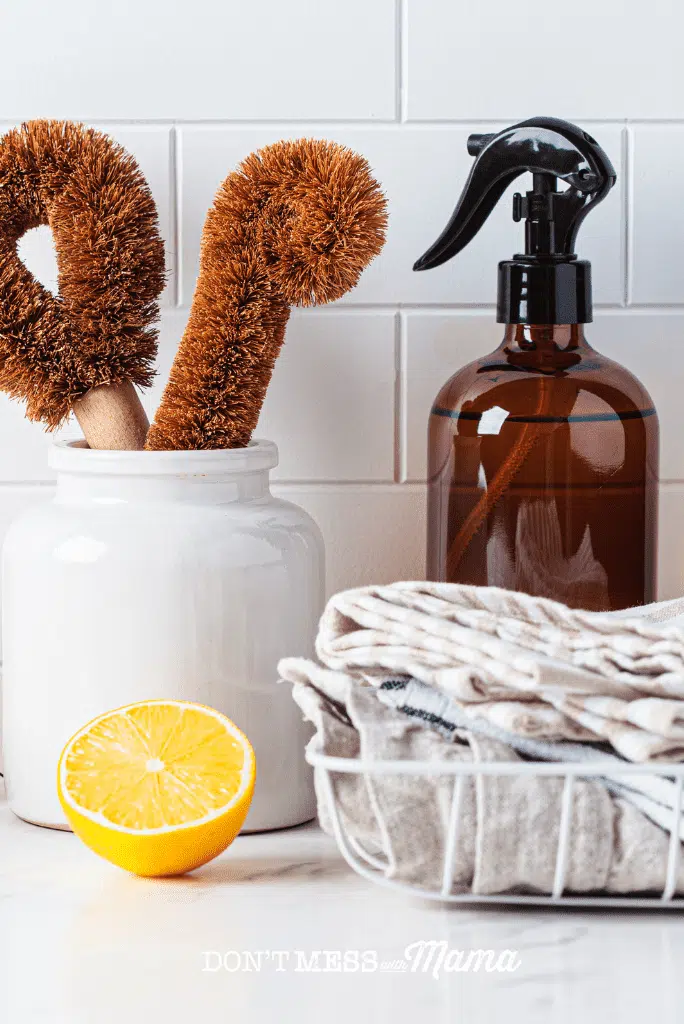
4 Simple & Natural Ways to Get Rid of Mold
These 4 ingredients are all great natural mold removers. Best of all, it’s likely you already have these items in your pantry, and if you don’t they are super cheap to buy. Not only will they kill mold naturally, but they can help to prevent it from returning – all without a toxic chemical in sight.
Vinegar
While there are items you should never clean with vinegar, mold is definitely not one of them. Vinegar is in fact one of the most effective and affordable ways to remove mold naturally, as it can kill around 82% of mold species.
This is because white vinegar usually contains around 5-8% acetic acid. This type of acid can disrupt the growth of mold as well as other fungi because it can penetrate both porous surfaces. This means it can attack the roots of the growth which in turn prevents the mold spores from growing.
Another reason vinegar is one of the best natural ways to kill mold is that unlike harsher chemical products, vinegar is non-toxic so it won’t harm your family or pets. White distilled vinegar is best (typically sold with 5% acidity) although you can also use apple cider vinegar.
How to use vinegar to kill mold
- To kill mold naturally using vinegar, mix 1 part vinegar with 1 part water in a spray bottle.
- Spray it onto the affected area and leave to work its magic for 1-2 hours. For particularly stubborn areas, you may need to scrub using a brush with soft bristles.
- Wipe the surface with a damp cloth then leave the area to dry completely.
- It’s important you do not rinse or wash off the vinegar as the additional moisture can encourage mold regrowth.
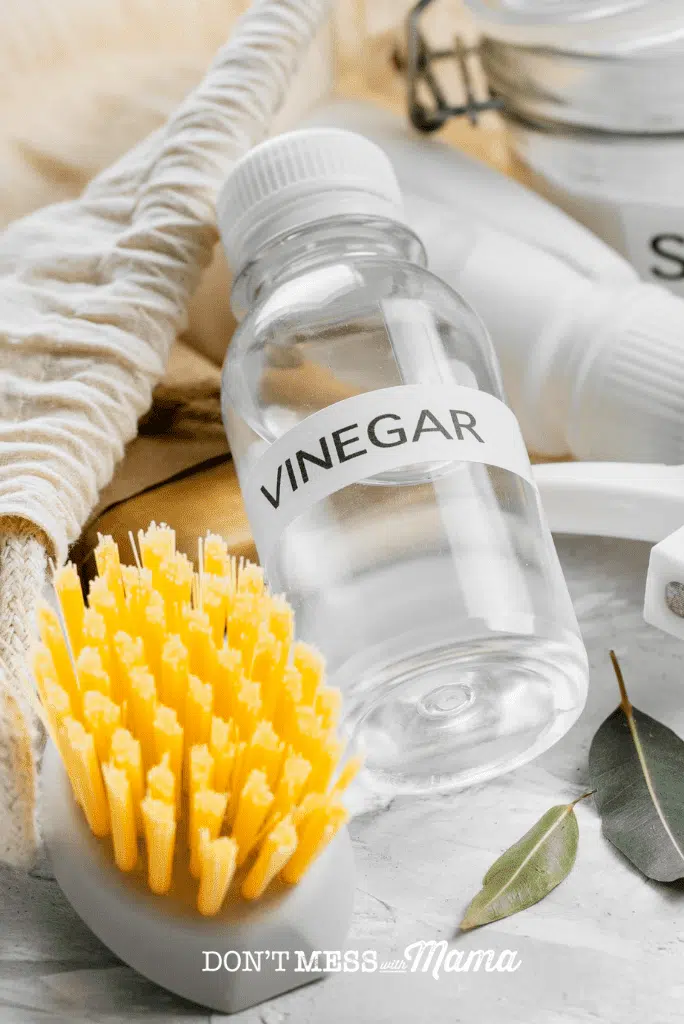
Hydrogen Peroxide
From mouthwash to firs aid, carpet cleaner to whitening laundry there are so many uses for hydrogen peroxide around the home. Hydrogen peroxide is a great natural mold remover as it is a safer, more environmentally friendly alternative to bleach. It is a biodegradable material that is made with one part water and two parts oxygen. As it releases oxygen at a rapid rate, it breaks down essential components such as proteins and DNA which the mold needs to survive.
It is best to avoid using hydrogen peroxide on porous surfaces such as fabric or wood as it can bleach them. However, it is safe on most solid surfaces in your home such as glass, shower bases or countertops. It is best to always test on an inconspicuous area first.
How to use hydrogen peroxide to kill mold
- Simply pour 3% hydrogen peroxide into a spray bottle (this is the standard percentage that you can buy from the pharmacy or store.)
- Spritz the solution directly onto the affected area.
- Let it sit for around 10 minutes before wiping it away with a rag or sponge.
- You may need to use a soft brush or repeat the process on areas with particularly nasty mold patches. Don’t forget to wipe the surface dry.
Note: Although vinegar and hydrogen peroxide are great natural ways to kill mold never use them both together. If you mix vinegar with hydrogen peroxide, this will create a toxic chemical called peracetic acid. This toxic substance can potentially irritate your skin, eyes and lungs.
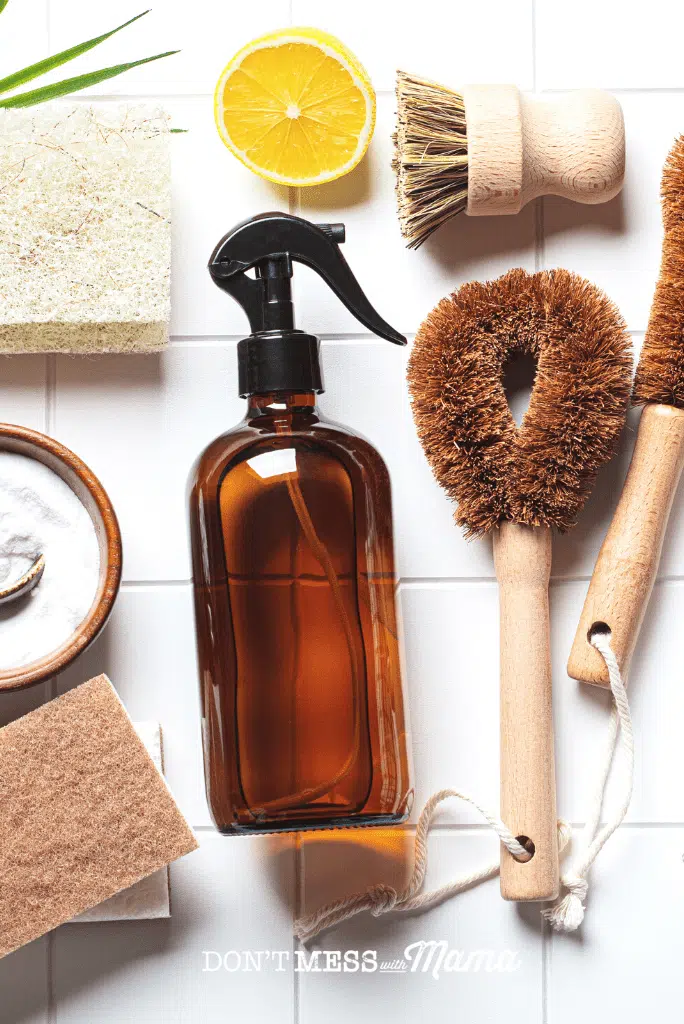
Baking Soda
Baking soda is not only convenient because most households have some, but it is environmentally, pet and child friendly to use. It’s also inexpensive and easy to find in the store if you don’t have some already in your pantry. From clearing drains to deodorizing carpets there are so many uses for baking soda, this includes getting rid of mold.
Using baking soda is a great way to get rid of mold naturally, particularly on bathroom grout as the baking soda is both abrasive and absorbs moisture which attracts mold in the first place. It’s actually the main ingredient in my DIY grout cleaner recipe. It also helps to neutralize odors so it can help to get rid of any musty smells that are commonly associated with mold.
However, unlike vinegar, it cannot penetrate porous materials deeply enough to actually kill mold at its roots. This means, baking soda is best for removing mold at the surface level but may not kill it entirely.
How to use baking soda to remove mold
- Just mix equal parts of baking soda and water together until you have a thick paste.
- Apply this paste over the affected area then scrub it in using an old toothbrush or soft brush. Let sit for a couple of hours until it dries.
- The dried paste will wipe off along with any visible mold.
- Repeat the process until all mold is removed.
If the area is more delicate, you can also make a baking soda spray solution instead of an abrasive paste. Add 1 teaspoon of baking soda to 2 cups of water and add the solution to a spray bottle. Spray the moldy area, leave for one hour then wipe with a damp cloth.
Whether you have used the paste or spray solution, it may also be a good idea to mist the area with vinegar to prevent the mold from returning. Add white distilled vinegar to a clean spray bottle and apply a light mist to the surface you just cleaned. Allow it to dry but do not wipe it. Make sure not to saturate the surface, a light misting should be enough to affect the acidity of the area and discourage mold from regenerating.
If you find places such as your shower stall or bathroom tiles are frequently affected by mold it is a good idea to mist the area with vinegar after each use or use my DIY shower spray. However, if you find mold in an area such as windows or in your basement, it’s important to treat the root cause and possibly contact a professional to find a permanent solution.
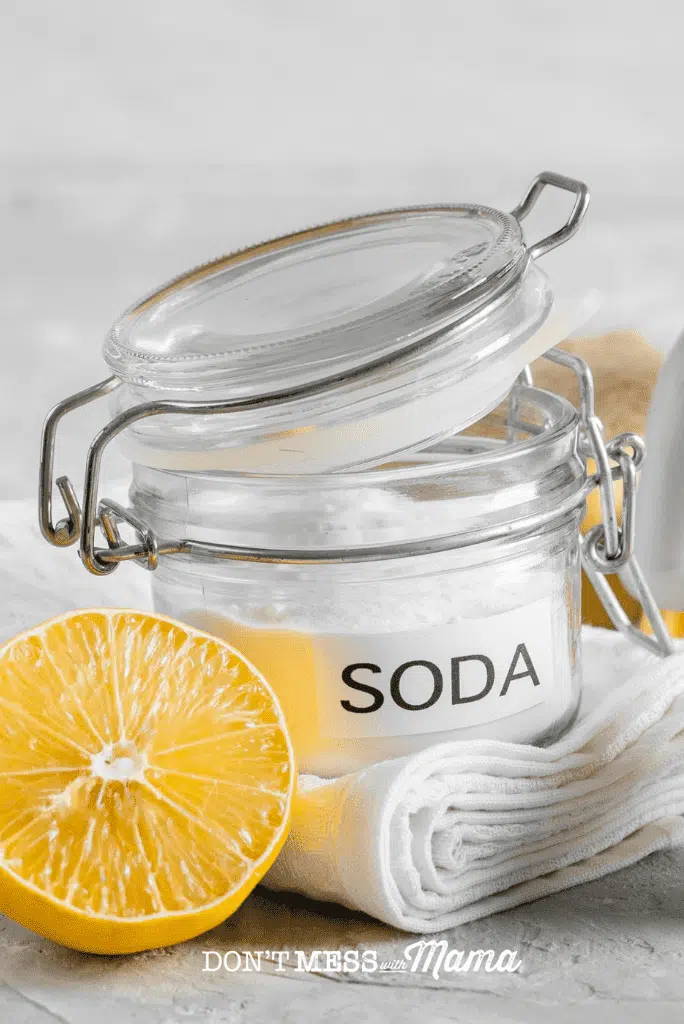
Lemon Juice
Similar to vinegar, lemon juice is 5% acidic making it a great natural mold remover. As it contains citric acid, it is also naturally antibacterial, and antiseptic and can be used to make a great natural alternative to bleach. While you can use the lemon juice to kill mold, save the peels for my DIY disinfectant spray.
Not only is it effective and environmentally friendly, but it’s less harsh and easier to clean up than bleach or other popular toxic products. Some may also prefer using lemon juice as the smell is far more pleasant than vinegar.
Lemon juice can be used to kill mold naturally whether it’s diluted with water or not. The purer your solution, the more effective it will be. It can also be blended with salt, baking soda or borax to create a paste which again, will make it more effective. The paste is best for more stubborn mold stains as it’s more abrasive so may damage fabric or porous material.
How to use lemon juice to kill mold
- Juice 4-6 lemons and use either directly or dilute 50/50, or 25/75 with water. The dilution you choose will depend on how bad the affected area is.
- Spray the solution onto the mold and let it to sit for 10 minutes. This allows the acidity to work it’s magic. If there are some tougher patches you may need to scrub them with a soft brush.
- Use a dry cloth dipped in warm water to wipe off any residue. Don’t forget to dry the area thoroughly using another soft cloth or paper towel as moisture is the enemy in mold prone areas.

How to Prevent Mold
Although you have now learned of 4 natural ways to kill mold, prevention is always easier than cure. These tips will help to prevent it occurring in the first place as well as the return of mold in the future.
Low humidity
It’s important to maintain low humidity levels, as mentioned no higher than 55%. This can be done using a dehumidifier which helps to remove moisture in the air. If you regularly dry laundry indoors, have a large collection of house plants or prefer long steamy showers, a dehumidifier can help to absorb the additional moisture.
It’s worth remembering that humidity levels change depending on the time of day, so if you are going to test your home, it’s best to do it at various times throughout the day.
Repair or replace
While this is may be obvious, it’s important to replace or remove carpets and upholstery in places than cannot be dried immediately. This includes after flooding or leaks (ideally within 24-48 hours.) Ideally, avoid carpets in areas such as bathrooms or basements as these are high moisture areas so it will encourage mold growth.
It’s important to fix any leaks around windows, pipes, drainpipes and seals before mold growth has begun. These areas allow additional moisture into your home which again, will encourage mold.
Send Moisture Outside
Additionally, use an exhaust system in the kitchen or bathroom to vent steam. This will help keep mold at bay as the fans help to send moisture outside. If you do not have fans or vents in these high-moisture areas, you should remember to open windows when showering or cooking. This will help to increase natural air circulation with minimal effort.
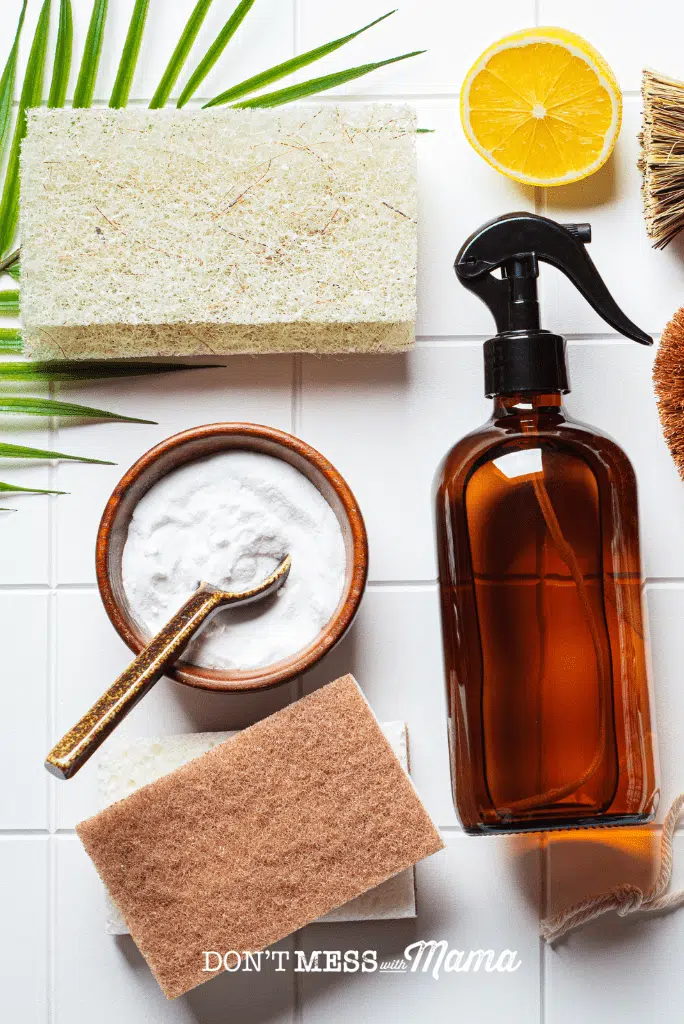
Thanks to these simple solutions it’s hopefully evident that it is possible to kill mold naturally. Not only will you save money, but you will also avoid exposing your family and pets to harmful chemicals. Don’t forget to use my tips to prevent mold to avoid any future flare ups and always seek professional help if necessary.
More Posts You Might Like
Did you try these natural ways to kill mold? Comment below to let me know how it went. You can also FOLLOW ME on Facebook, Instagram and Pinterest to see what other fun things I’m getting up to.
